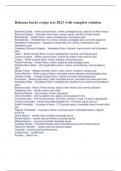Lecture 1: Key notions
--------------------------------------------------------------------------------------------------------------------------------------
Argument
• An ARGUMENT is any collection of premises together with a together
Indicate a conclusion
• To indicate an argument’s conclusion, the following words are often used:
o So, Therefore, Hence, Thus, Accordingly, Consequently,
Indicate a premises
• To indicate that we are dealing with a premise, the following expressions are often used:
o Since, Because, Given that,
Two ways for an argument to be BAD
• Content: One or more premises are false
• Form: Conclusion does not follow from premises
VALID
• An argument is VALID if and only if it is impossible for all of its premises to be true
and the conclusion false.
Example:
• Premises 1: Oranges are either fruits or musical instruments
• Premises 2: Oranges are not fruits
• Conclusion: Oranges are musical instruments
The conclusion of this argument is ridiculous. But it follows from the premises.
If both premises were true, then the conclusion just has to be true. So the argument above is VALID.
Remember:
Validity is not about the actual truth or falsity of the sentences in the argument!
It is about whether it is possible for al the premises to be true and the conclusion false.
INVALID
• An argument is INVALID if and only if it is possible for all of its premises to be true
and the conclusion false.
Sound
• An argument is SOUND if and only if it is both valid and all of its premises are true.
Type of arguments
• Deductive
o In a deductive argument, a conclusion follows necessarily from the stated premises.
• Inductive
o This argument generalises from observations about several cases in the past to a
conclusion about all cases.
• Abductive
o It can be seen as a way of generating explanations of a phenomena meeting certain
conditions
Summary
Made by: A.Azzam
, Truth Values
• Many kinds of English sentence cannot be used to express premises or conclusions of
arguments. For example:
o Questions (Are you feeling sleepy?)
o Imperatives (Wake up!)
o Exclamations (Ouch!)
General point
• The premises and conclusion of an argument must be capable of having a TRUTH VALUE.
• And the two truth values that concern us are just TRUE and FALSE.
Jointly Consistent
• Sentences are JOINTLY CONSISTENT if and only if it is possible for them all to be true
together
Jointly Inconsistent
• Sentences are JOINTLY INCONSISTENT if and only if it is NOT possible for them all to
be true together
Example:
• B1: Jane’s only brother is shorter than her.
• B2: Jane’s only brother is taller than her.
Remember!
• If sentences are already jointly inconsistent, adding an extra sentence to the mix will not make
them consistent!
Necessary truth
• A sentence is a NECESSARY TRUTH if and only if it is true and it is not possible for it to
be false
Example:
• Either it is raining here, or it is not
To check sentence 2 you do not need to look outside to know that it is true. It is raining or it’s not.
Remember!
• If you have this then you always have an VALID argument!
Necessary falsehood
• A sentence is a NECESSARY FALSEHOOD if and only if it is false and not possible for it
to be true.
Example:
• It is both raining here and not raining here.
To check sentence 3 is no needed! This sentence must be false. It impossible to be both raining and
not raining in the same place and at the same time.
Contingent
• A sentence is CONTINGENT if and only if it is possible for it to be true and possible for
it to be false.
Summary
Made by: A.Azzam
, Lecture 2: Truth-Functional Logic
--------------------------------------------------------------------------------------------------------------------------------------
Atomic Sentences
• Basic building blocks out of which all other (more complex) sentences are built
• Can stand alone or be sub sentences in more complex sentences
Example:
• Nathan is hungry
• Lincoln was shot
• Either Jobke is awake or she is snoring
• Nathan is not hungry and Jobke is snoring
Uppercase letters
• When we translate English into TFL, we replace all atomic sentences with
uppercase letters
Example:
• Nathan is hungry ---------------------------> H
• Lincoln was shot ---------------------------> S
• Either Jobke is awake or she is snoring ---------------------------> A or N
• Nathan is not hungry and Jobke is snoring --------------------------> Not -H and N
Symbolization Key
• A SYMBOLIZATION KEY specifies which atomic sentence each letter represents in the
relevant case
Example:
A Nathan is hungry
B Lincoln was shot
C Lincoln died
D Jobke is awake
E Jobke is snoring
Connectives
• These allow us to form new, complex sentences out of old ones
• These can be atomic sentences or other complex sentences
Symbol Name of Symbol Rough Meaning
¬ Negation It is not the case that..
∧ Conjunction Both…….And….
∨ Disjunction Either…..Or…..
→ Conditional If……Then……
↔ Biconditional ….If and only if……
Summary
Made by: A.Azzam
--------------------------------------------------------------------------------------------------------------------------------------
Argument
• An ARGUMENT is any collection of premises together with a together
Indicate a conclusion
• To indicate an argument’s conclusion, the following words are often used:
o So, Therefore, Hence, Thus, Accordingly, Consequently,
Indicate a premises
• To indicate that we are dealing with a premise, the following expressions are often used:
o Since, Because, Given that,
Two ways for an argument to be BAD
• Content: One or more premises are false
• Form: Conclusion does not follow from premises
VALID
• An argument is VALID if and only if it is impossible for all of its premises to be true
and the conclusion false.
Example:
• Premises 1: Oranges are either fruits or musical instruments
• Premises 2: Oranges are not fruits
• Conclusion: Oranges are musical instruments
The conclusion of this argument is ridiculous. But it follows from the premises.
If both premises were true, then the conclusion just has to be true. So the argument above is VALID.
Remember:
Validity is not about the actual truth or falsity of the sentences in the argument!
It is about whether it is possible for al the premises to be true and the conclusion false.
INVALID
• An argument is INVALID if and only if it is possible for all of its premises to be true
and the conclusion false.
Sound
• An argument is SOUND if and only if it is both valid and all of its premises are true.
Type of arguments
• Deductive
o In a deductive argument, a conclusion follows necessarily from the stated premises.
• Inductive
o This argument generalises from observations about several cases in the past to a
conclusion about all cases.
• Abductive
o It can be seen as a way of generating explanations of a phenomena meeting certain
conditions
Summary
Made by: A.Azzam
, Truth Values
• Many kinds of English sentence cannot be used to express premises or conclusions of
arguments. For example:
o Questions (Are you feeling sleepy?)
o Imperatives (Wake up!)
o Exclamations (Ouch!)
General point
• The premises and conclusion of an argument must be capable of having a TRUTH VALUE.
• And the two truth values that concern us are just TRUE and FALSE.
Jointly Consistent
• Sentences are JOINTLY CONSISTENT if and only if it is possible for them all to be true
together
Jointly Inconsistent
• Sentences are JOINTLY INCONSISTENT if and only if it is NOT possible for them all to
be true together
Example:
• B1: Jane’s only brother is shorter than her.
• B2: Jane’s only brother is taller than her.
Remember!
• If sentences are already jointly inconsistent, adding an extra sentence to the mix will not make
them consistent!
Necessary truth
• A sentence is a NECESSARY TRUTH if and only if it is true and it is not possible for it to
be false
Example:
• Either it is raining here, or it is not
To check sentence 2 you do not need to look outside to know that it is true. It is raining or it’s not.
Remember!
• If you have this then you always have an VALID argument!
Necessary falsehood
• A sentence is a NECESSARY FALSEHOOD if and only if it is false and not possible for it
to be true.
Example:
• It is both raining here and not raining here.
To check sentence 3 is no needed! This sentence must be false. It impossible to be both raining and
not raining in the same place and at the same time.
Contingent
• A sentence is CONTINGENT if and only if it is possible for it to be true and possible for
it to be false.
Summary
Made by: A.Azzam
, Lecture 2: Truth-Functional Logic
--------------------------------------------------------------------------------------------------------------------------------------
Atomic Sentences
• Basic building blocks out of which all other (more complex) sentences are built
• Can stand alone or be sub sentences in more complex sentences
Example:
• Nathan is hungry
• Lincoln was shot
• Either Jobke is awake or she is snoring
• Nathan is not hungry and Jobke is snoring
Uppercase letters
• When we translate English into TFL, we replace all atomic sentences with
uppercase letters
Example:
• Nathan is hungry ---------------------------> H
• Lincoln was shot ---------------------------> S
• Either Jobke is awake or she is snoring ---------------------------> A or N
• Nathan is not hungry and Jobke is snoring --------------------------> Not -H and N
Symbolization Key
• A SYMBOLIZATION KEY specifies which atomic sentence each letter represents in the
relevant case
Example:
A Nathan is hungry
B Lincoln was shot
C Lincoln died
D Jobke is awake
E Jobke is snoring
Connectives
• These allow us to form new, complex sentences out of old ones
• These can be atomic sentences or other complex sentences
Symbol Name of Symbol Rough Meaning
¬ Negation It is not the case that..
∧ Conjunction Both…….And….
∨ Disjunction Either…..Or…..
→ Conditional If……Then……
↔ Biconditional ….If and only if……
Summary
Made by: A.Azzam










